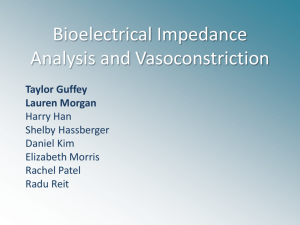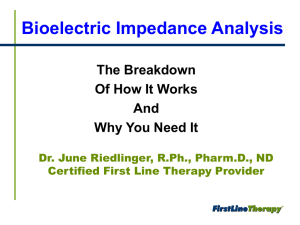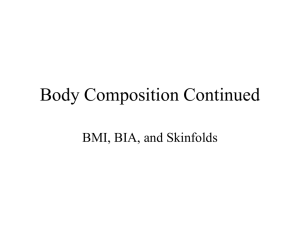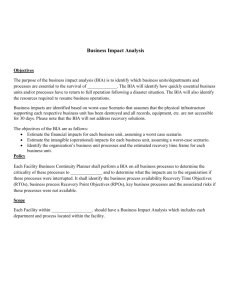Accuracy of Consumer Grade Bioelectrical Impedance Analysis
advertisement
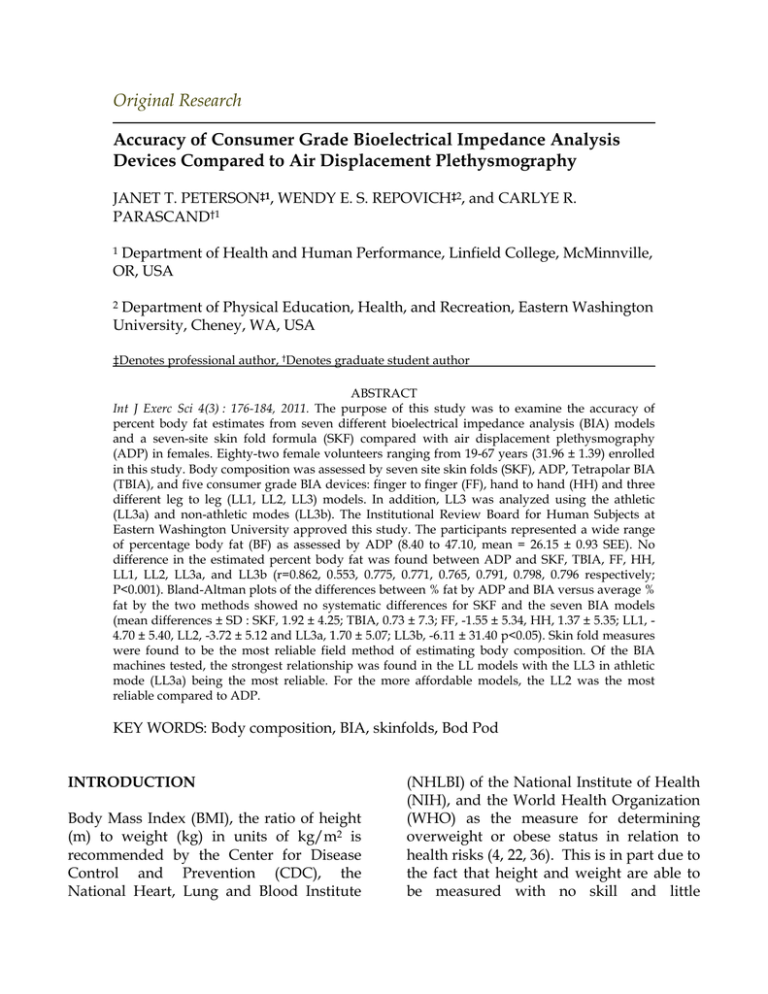
Original Research Accuracy of Consumer Grade Bioelectrical Impedance Analysis Devices Compared to Air Displacement Plethysmography JANET T. PETERSON‡1, WENDY E. S. REPOVICH‡2, and CARLYE R. PARASCAND†1 Department of Health and Human Performance, Linfield College, McMinnville, OR, USA 1 Department of Physical Education, Health, and Recreation, Eastern Washington University, Cheney, WA, USA 2 ‡Denotes professional author, †Denotes graduate student author ABSTRACT Int J Exerc Sci 4(3) : 176-184, 2011. The purpose of this study was to examine the accuracy of percent body fat estimates from seven different bioelectrical impedance analysis (BIA) models and a seven-site skin fold formula (SKF) compared with air displacement plethysmography (ADP) in females. Eighty-two female volunteers ranging from 19-67 years (31.96 ± 1.39) enrolled in this study. Body composition was assessed by seven site skin folds (SKF), ADP, Tetrapolar BIA (TBIA), and five consumer grade BIA devices: finger to finger (FF), hand to hand (HH) and three different leg to leg (LL1, LL2, LL3) models. In addition, LL3 was analyzed using the athletic (LL3a) and non-athletic modes (LL3b). The Institutional Review Board for Human Subjects at Eastern Washington University approved this study. The participants represented a wide range of percentage body fat (BF) as assessed by ADP (8.40 to 47.10, mean = 26.15 ± 0.93 SEE). No difference in the estimated percent body fat was found between ADP and SKF, TBIA, FF, HH, LL1, LL2, LL3a, and LL3b (r=0.862, 0.553, 0.775, 0.771, 0.765, 0.791, 0.798, 0.796 respectively; P<0.001). Bland-Altman plots of the differences between % fat by ADP and BIA versus average % fat by the two methods showed no systematic differences for SKF and the seven BIA models (mean differences ± SD : SKF, 1.92 ± 4.25; TBIA, 0.73 ± 7.3; FF, -1.55 ± 5.34, HH, 1.37 ± 5.35; LL1, 4.70 ± 5.40, LL2, -3.72 ± 5.12 and LL3a, 1.70 ± 5.07; LL3b, -6.11 ± 31.40 p<0.05). Skin fold measures were found to be the most reliable field method of estimating body composition. Of the BIA machines tested, the strongest relationship was found in the LL models with the LL3 in athletic mode (LL3a) being the most reliable. For the more affordable models, the LL2 was the most reliable compared to ADP. KEY WORDS: Body composition, BIA, skinfolds, Bod Pod INTRODUCTION Body Mass Index (BMI), the ratio of height (m) to weight (kg) in units of kg/m2 is recommended by the Center for Disease Control and Prevention (CDC), the National Heart, Lung and Blood Institute (NHLBI) of the National Institute of Health (NIH), and the World Health Organization (WHO) as the measure for determining overweight or obese status in relation to health risks (4, 22, 36). This is in part due to the fact that height and weight are able to be measured with no skill and little ACCURACY OF CONSUMER GRADE BIA DEVICES experience. The common complaint about using body mass index is it does not take into account adiposity or body fat distribution and is prone to misclassifications based on size, gender, age and race (1, 9). Other studies suggest that overall body fatness, and particularly adiposity in the abdominal region is more predictive of health risks than BMI (9, 32). There are many methods of measuring body composition including hydrostatic weighing, skin fold thickness (SKF), tetrapolar bioelectrical impedance analysis (BIAT), air displacement plethysmography (ADP) and dual-energy x-ray absorptiometry (DEXA). These methods are more expensive, require specific equipment and training and/or are time consuming to use. These instruments provide valid estimates of total body water (TBW) and fat free mass (FFM) and thus can estimate percent body fat (%BF). User-friendly segmental BIA analyzers use impedance measures from the segments to estimate %BF from a density value because the measures of TBW are not always valid in segments vs. the whole body analysis (9, 12). The user-friendly, inexpensive (< $75.00) BIA analyzers are segmental hand-to-hand or leg-to-leg models with one inexpensive model ($12.00) available the Sportsline® fingers-to-fingers device. These segmental models measure body composition by determining impedance to a low electrical current (50Hz) that is sent through specific segments of the body, i.e., limb-to-limb (2, 11, 12). The current passes freely through the fluid compartments of the body, but encounters resistance when it passes through fat tissue, which is anhydrous. This impedance value is then used in an equation chosen by the manufacturer to determine body density and percent body fat. Previous research suggests that BIA models may not be reliable for estimating body composition in a range of populations because the equations are specific to the group on which they were established (9, 11, 18, 28). In addition the formulas used in each of these user-friendly analyzers are proprietary to each manufacturer and not reported in their literature. They allow for selection by gender and in some machines by athletic or non-athletic but without a specific definition to follow for that identity. This makes it difficult to determine the appropriate population to use with each machine (12). Therefore, the purpose of the present study was to examine the accuracy of %BF estimates from seven different BIA models and a Practical, inexpensive, reliable measurement tools for body composition are needed for individuals and in many measurement settings such as for worksite health risk assessments, epidemiological studies, commercial weight loss programs and athletics (8, 20, 21, 35). Overweight and obesity rates are rising fast enough that inexpensive valid and reliable methods to track changes in body composition are in high demand. Bioelectrical impedance analysis (BIA) is a method that is easy to use, inexpensive and readily available. The technology has been in use for over 100 years (6), but BIA for estimating body composition was only introduced in the 1980’s (2, 6). Currently there are many inexpensive BIA machines (< $100) on the market (11) but little research has been published about their validity or reliability. Traditional clinical BIA methods, BIAT, measure whole body resistance using wrist to ankle (tetrapolar) surface electrodes (9). International Journal of Exercise Science 177 http://www.intjexersci.com ACCURACY OF CONSUMER GRADE BIA DEVICES seven-site SKF compared with ADP in females. Percentage body fat by skinfolds (Lange Calipers, Ann Arbor, MI) was estimated using the seven-site skin fold formula originally described by Jackson, Pollock and Ward (14). The seven sites used were tricep, subscapular, chest, abdominal, suprailiac, mid-axillary and thigh. The Siri equation was used to calculate body fat percentage from body density (Siri). The two technicians collecting the skinfold measures were certified by the ACSM and very experienced in the correct techniques. METHODS Participants Eighty-two white female volunteers, ages 19-67 were recruited from the Eastern Washington University community for this study. All were relatively healthy and not pregnant. All participants were requested to abstain from eating or drinking for two hours before testing and to urinate immediately prior to data collection. In addition, subjects were asked to not participate in moderate or vigorous exercise for 24 hours prior to testing. The Institutional Review Board for Human Subjects (IRB) at Eastern Washington University approved this study and all participants signed an informed consent prior to testing. Bioelectrical Impedance Analysis The six different BIA devices used for estimating percentage body fat were a research-grade tetrapolar BIA (BIAT) (Electrolipograph System, ELG, Bioanalogics, Portland, OR), one clinical grade leg to leg BIA which allows two measures, athletic and standard (LL3a and LL3s) (Tanita 300®, Tanita Corporation of America, Inc., Arlington Heights, IL) and four consumer grade BIA devices: finger to finger (FF) (Sportline®, Sportline, Yonkers, NY), hand to hand (HH) (Omron® HBF 306, Omron, Corp., Schaumburg, IL) and two leg to leg measures using two devices from the same manufacturer (LL1 and LL2) (Tanita 2204® and Tanita 679®, Tanita corporation of America, Inc., Arlington Heights, IL). All measurements were taken in accordance with the manufacturer’s suggested technique. Subjects wore minimal clothing (bathing suit) and all measurements were completed within a 30minute time frame. Protocol All testing was completed in one day. Anthropometric measurements were taken, including height and weight using a beam scale and stadiometer (Detecto Physician Scale, Cardinal Scale Manufacturing Co., Webb City, MO) with the subject in minimal clothing and without shoes. Body composition was assessed by different methods including seven-site SKF, ADP and BIA using six different devices. The first test for all participants was the BIAT because the standard procedure requires the subject to lie supine for 10 minutes prior to the measurement. The rest of the field methods were completed in a counterbalanced order with the ADP the final test for everyone. Air Displacement Plethysmography Immediately following the BIA measurements, body fat percentage was estimated by ADP (Bod Pod® Life Measurement, Inc. Concord, CA). Subjects were required to wear a bathing suit and Skin Folds International Journal of Exercise Science 178 http://www.intjexersci.com ACCURACY OF CONSUMER GRADE BIA DEVICES swim cap for the ADP measurements. Procedures for estimating %BF using the Bod Pod® were completed including the measurement of residual lung volume following the manufacturer’s guidelines. the manufacturer suggested retail price (MSRP) for each are listed in Table 2. Table 1: Participant Characteristics (n=82) Parameter Mean ± SD (range) Statistical Analysis Data were analyzed using Statistical Package for the Social Sciences (SPSS, version 12.0, Chicago, Illinois) and MedCalc Software for Windows (version 8.0.2.0, Mariakerke, Belgium). Statistical significance was set at p ≤ 0.05. Pearson’s correlation coefficients were calculated to evaluate the relationship between %BF by ADP and all other methods and SEE were calculated for each comparison. A one-way repeated measures ANOVA was calculated to detect significant differences across the body composition variables. Paired samples t-tests were then used to compare the mean percent fat as assessed by ADP with SKF and the seven BIA methods. Posthoc pair-wise comparisons with Bonferroni adjustments were conducted. Since all measures were significantly correlated Bland-Altman plots (3) were used to examine the individual agreement between ADP and SKF of the individual BIA methods. 32.0 ± 12.6 (19.0- 67.0) Height (cm) Weight (kg) 167.2 ± 6.0 (154.0 183.0) 65.8 ± 9.8 (48.5 - 91.2) BMI (kg/m2) 23.5 ± 0.06 (18.7 – 32.7) % Fat ADP 26.15 ± 8.4 (8.4 – 47.1) BMI: Body Mass Index; SD: Standard Deviation ADP: Air Displacement Plethysmography Table 2: Pearson r and SEE for all methods compared to ADP RESULTS Anthropometric measurements (Means ± SD and range) for all participants are listed in Table 1. Body fat percent as measured by SKF, BIAT, BIA3a, BIA3s and the four consumer grade models of BIA were all significantly correlated to body fat percent as measured by ADP. The correlations ranged from moderate (r = 0.553) for the FF BIA model to strong (r = 0.862) for the SKF technique with the majority in the mid to high r = 0.70. Pearson’s correlation values for all methods compared to ADP as well as International Journal of Exercise Science Age (years) Method ADP SEE MSRP+ SKF 0.862a 4.27 $309 TBIA 0.553 a 7.06 $5000 FF 0.775 a 5.33 $12 HH 0.771 a 5.37 $60 LL1 0.765 a 5.43 $65 LL2 0.791 a 5.16 $65 LL3a 0.798 a 5.08 $2000 LL3s 0.796a 5.10 $2000 p ≤ 0.05, SEE: Standard Error of the Estimate + MSRP: Approximate Manufacturers Suggest Retail Price a Figure 1 represents the mean %BF for all methods. Following the ANOVA, post-hoc Bonferroni adjustments identified the %BF measures that were significantly different than ADP. Those that significantly over estimated %BF were the BIA methods FF, LL1, LL2 and LL3s and underestimated was LL3a in comparison to ADP. The three measures that were not significantly 179 http://www.intjexersci.com ACCURACY OF CONSUMER GRADE BIA DEVICES different than ADP and all under estimated %BF. Bland-Altman plots of the differences between %BF by ADP and BIA versus average %BF by the two methods showed no systematic differences for SKF and the seven BIA models (mean differences ± SD: SKF, 1.92 ± 4.25; BIAT, 0.73 ± 7.3; FF, -1.55 ± 5.34, HH, 1.37 ± 5.35; LL1, -4.70 ± 5.40, LL2, -3.72 ± 5.12, LL3s, 1.70 ± 5.07; and LL3a, 6.11 ± 31.40). The Bland-Altman Plots are shown in Figure 2. population specific prediction algorithms their accuracy in a general population must be questioned (28). In the current study, percent body fat estimations from all BIA models were significantly though only moderately correlated (r = 0.553 – r = 0.798) with the selected criterion method, ADP. The lowest was with the research-grade BIAT and the highest was the clinical-grade LL3s. The correlation with SKF was the highest of all methods at r = 0.862. BlandAltman plots revealed no systematic error in estimation of percentage body fat with SKF or any of the BIA methods from ADP. However, the SEE values associated with the %BF measurement estimates were relatively high (4.27% for SKF to 7.06% for the TBIA) and thus the precision of these devices must be questioned in a female population. Figure 1: Mean body fat percent by all methods. * indicates that the mean is significantly different than the ADP measurement. DISCUSSION Having an accurate measure of body composition that is accessible in terms of price, ease of use (does not require a technician) and availability is of increasing interest in many fields (9). As many of the consumer grade BIA models rely on International Journal of Exercise Science Figure 2a. Regression plots of percent body fat by ADP against all variables. 180 http://www.intjexersci.com ACCURACY OF CONSUMER GRADE BIA DEVICES Figure 2b. Bland-Altman plots indicating no systematic differences in estimating body fat percent by ADP and all variables. available tool for estimation of body composition in a general population. Some researchers advocate that BIA may be a useful measurement tool for clinical and public health settings even if the measure is not valid, suggesting it can be reliable to show percent body fat change over time (15, 16). It may be more important for further research to be longitudinal especially in females to determine whether the machines consistently over time, over or under estimate %BF in individuals both with and without weight loss. Since even the research-grade BIAT devices have presented inconsistent results in their accuracy at estimating body fat in a variety of populations work is continuing to develop more valid machines. Some research is suggesting the newer octopolar segmental devices may be a more accurate predictor of body composition when compared to the tetrapolar devices (16) because they report %BF in segments, arms, legs and trunk as well as %BF. However, the octopolar devices currently available are significantly more expensive (> $3,000.00) and may not be readily available to the general population. Body weight, BMI, waist circumference and body composition are all measures commonly used to assess risk for Current research indicates that there is no consensus on the usability and accuracy of segmental BIA devices in various populations. Our results support previous studies which indicate that segmental BIA measures correlate well with a criterion method but under or overestimate the individual %BF measures (5, 19, 24). Other studies suggest that segmental BIA provides a relatively accurate estimate of percentage body fat in specific populations such as high school aged children (17, 21), male wrestlers (32) and the elderly (26). At least two studies specifically indicated that BIA measures are not valid in female populations (10, 13) as was found in the current study. It is possible that there is greater variation in the location of fat deposition in females which makes it more difficult to use a single generic formula to accurately measure %BF using segmental BIA models. The large SEE in the present study as can be seen in the Bland Altman Plots shows the wide variation. Segmental BIA is a promising technology for an easy to use, inexpensive and readily International Journal of Exercise Science 181 http://www.intjexersci.com ACCURACY OF CONSUMER GRADE BIA DEVICES 4. CDC Home, Healthy weight – it’s not a diet, it’s a lifestyle! 2011. Retrieved from http://www.cdc.gov/healthyweight/index.html cardiovascular disease. Of these, body composition measures provide a more accurate indication of body fatness, which is associated with increased cardiovascular and metabolic morbidity and mortality (30). Segmental BIA provides an acceptable significant correlation with criterion methodologies but may not be accurate enough to give precise, reliable individual body composition measurements. Segmental BIA devices may be better used as a measure to assess percentage body fat changes overtime such as in a weight loss program. In the current study SKF had the highest correlation and the lowest SEE when compared to ADP, which is consistent with other studies (13, 25), but skinfold assessment cannot be done alone and require a skilled technician for validity and reliability (22) while BIA measures can be done alone. For reliability when using SKF, the same technician should complete each measurement, if this is not possible; when repeated measurements are required BIA might be a better option. More research in longitudinal studies and on the octopolar BIA devices is needed before recommendations for their use as a clinical tool can be made. 5. Chouinard LE, Schoeller DA, Watras AC, Clark RR, Close RN, Buchholz AC. Bioelectrical impedance vs. four-compartment model to assess body fat change in overweight adults. Obes. 15: 8592, 2007. 6. Cornish B. Bioimpedance analysis: Scientific background. Lymphat Res Biol. 4(1): 47-50, 2006. 7. Dempster P, Aitkens S. A new air displacement method for the determination of human body composition. Med Sci Sports Exerc. 12: 1692-1697, 1995. 8. Elberg J, McDuffie JR, Sebring NG, Salaita C., Keil M, Robotham D, Reynolds JC, Yanovski JA. Comparison of methods to assess change in children's body composition. Am J Clin Nutr. 80(1): 64-69, 2004. 9. Going S. Optimizing techniques for determining body composition. Gatorade Sports Science Institute, Sports Science Exchange. 19(2): 1-6, 2006. 10. Hemmingsson E, Uddén J, Neovius M. No apparent progress in bioelectrical impedance accuracy: validation against metabolic risk and DXA. Obes. 17: 183-187, 2009. 11. Heyward V. ASEP methods recommendation: Body composition assessment. J Exerc Physiol online. 4(4): 1-12, 2001. REFERENCES 12. Heyward VH, Wagner DR, eds. Applied Body Composition Assessment. 2nd ed. Champaign, IL: Human Kinetics 2004. 1. Andreoli A, Melchiorri G, Lorenzo AD, Caruso I, Salimei PS, Guerrisi M. Bioelectrical impedance measures in different position vs dual-energy X-ray absorptiometry (DXA). J Sports Med Phys Fitness. 42: 186-189, 2002. 13. Isjwara RI, Lukito W, Schultink JW. Comparison of body compositional indices assessed by underwater weighting, bioelectrical impedance and anthropometry in Indonesian adolescent girls. Asia Pac J Clin Nutr. 16(4): 641-648, 2007. 2. Baumgartner RN, Ross R, Heymsfield SB. Does adipose tissue influence bioelectrical impedance in obese men and women? J Appl Physiol. 84(1): 257262, 1998. 14. Jackson AS, Pollock ML, Ward A. Generalized equations for predicting body density of women. Med Sci Sports Exerc. 12(3): 175-181, 1980. 3. Bland JM, Altman DG. Statistical methods for assessing agreement between two methods of clinical measurement. Lancet. 1: 307-317, 1986. International Journal of Exercise Science 182 http://www.intjexersci.com ACCURACY OF CONSUMER GRADE BIA DEVICES 15. Jaffrin MY. Body composition determination by bioimpedance: an update. Curr Opin Clin Nutr Metab Care. 12(5): 482-486, 2009. 25. Piers LS, Soares MJ, Frandsen SL, O'Dea K. Indirect estimates of body composition are useful for groups but unreliable in individuals. Int J Obes. 24: 1145-1152, 2000. 16. Jaffrin MY, Morel H. Measurements of body composition in limbs and trunk using a eight contact electrodes impedancemeter. Med Eng Physiol. 31(9): 1079-1086, 2009. 26. Ritchie JD, Miller CK, Smiciklas-Wright H. Tanita foot-to-foot bioelectrical impedance analysis system validated in older adults. J Am Diet Assoc. 105: 1617-1619, 2005. 17. Kriemler S, J JP, Zahner L, Roth R, BraunFahrländer C, Bedogni G. Cross-validation of bioelectrical impedance analysis for the assessment of body composition in a representative sample of 6to 13-year-old children. Eur J Clin Nutr. 63(5): 619626, 2009. 27. Siri, W. E. (1961). Body composition from fluid space and density. In J. Brozek & A. Hanschel (Eds.), Techniques for measuring body composition (pp. 223-244). Washington, DC: National Academy of Science. 18. Kyle UG, Bosaeus I, Lorenzo ADD, et al. Bioelectrical impedance analysis - part 1: review of principles and methods. Clin Nutr. 23: 1226-1243, 2004. 28. Stahn A, Terblanche E, Strobel G. Modeling upper and lower limb muscle volume by bioelectrical impedance analysis. J Appl Physiol. 103: 1428-1435, 2007. 19. LaForgia J, Gunn SM, Withers RT. Body composition: validity of segmental bioelectrical impedance analysis. Asia Pac J Clin Nutr. 17(4): 586591, 2008. 20. Lazzer S, Boirie Y, Meyer M, Vermorel M. Evaluation of two foot-to-foot bioelectrical impedance analysers to assess body composition in overweight and obese adolescents. Br J Nutr. 90: 987-992, 2003. 29. Swartz AM, Evans MJ, King GA, Thompson DL. Evaluation of a foot-to-foot bioelectrical impedance analyser in highly active, moderately active and less active young men. Br J Nutr. 88: 205-210, 2002. 30. Thalmann S, Meier CA. Local adipose tissue depots as cardiovascular risk factors. Cardiovasc Res. 75(4): 690-701, 2007. 31. Thomspson WR, Gordon NF, Pescatello LS, eds. ACSM's Guidelines for Exercise Testing and Prescription. 8th ed. Baltimore, MD: Lippincott Williams & Wilkins; 2010. 21. Lintsi M, Kaarma H, Kull I. Comparison of handto-hand bioimpedance and anthropometry equations versus dual-energy X-ray absorptiometry for the assessment of body fat percentage in 17-18year old conscripts. Clin Physiol Funct Imaging. 24: 85-90, 2004. 32. Utter AC, Lambeth PG. Evaluation of multifrequency bioelectrical impedance analysis in assessing body composition of wrestlers. Med Sci Sports Exerc. 42(2): 361-367, 2010. 22. Lohman TG. Advances in body composition assessment. Champaign, IL: Human Kinetics; 1992. 33. Valdez R, Seidell JC, Young AI, Weiss KM. A new index of abdominal adiposity as an indicator of risk for cardiovascular disease. A cross population study. Int J Obes. 17: 77-82, 1993. 23. National Heart L, and Blood Institute. Clinical guidelines on the identification, evaluation, and treatment of overweight and obesity in adults: The evidence report. Bethesda (MD): National Institutes of Health; 1998. 34. Wagner DR, Heyward VH, Gibson AL. Validation of air displacement plethysmography for assessing body composition. Med Sci Sports Exerc. 32: 1339-1344, 2000. 24. Pateyjohns IR, Brinkworth GD, Buckley JD, Noakes M, Clifton PM. Comparison of three bioelectrical impedance methods with DXA in overweight and obese men. Obes. 14: 2064-2070, 2006. International Journal of Exercise Science 35. Weyers AM, Mazzetti SA, Love DM, Gomez AL, Kraemer WJ. Comparison of methods for assessing 183 http://www.intjexersci.com ACCURACY OF CONSUMER GRADE BIA DEVICES body composition changes during weight loss. Med Sci Sports Exerc. 34: 3497-502, 2002. 36. WHO STEPS Surveillance Manual, 2008, Section 3. Retrieved from http://www.who.int/chp/steps/manual/en/index .html International Journal of Exercise Science 184 http://www.intjexersci.com
